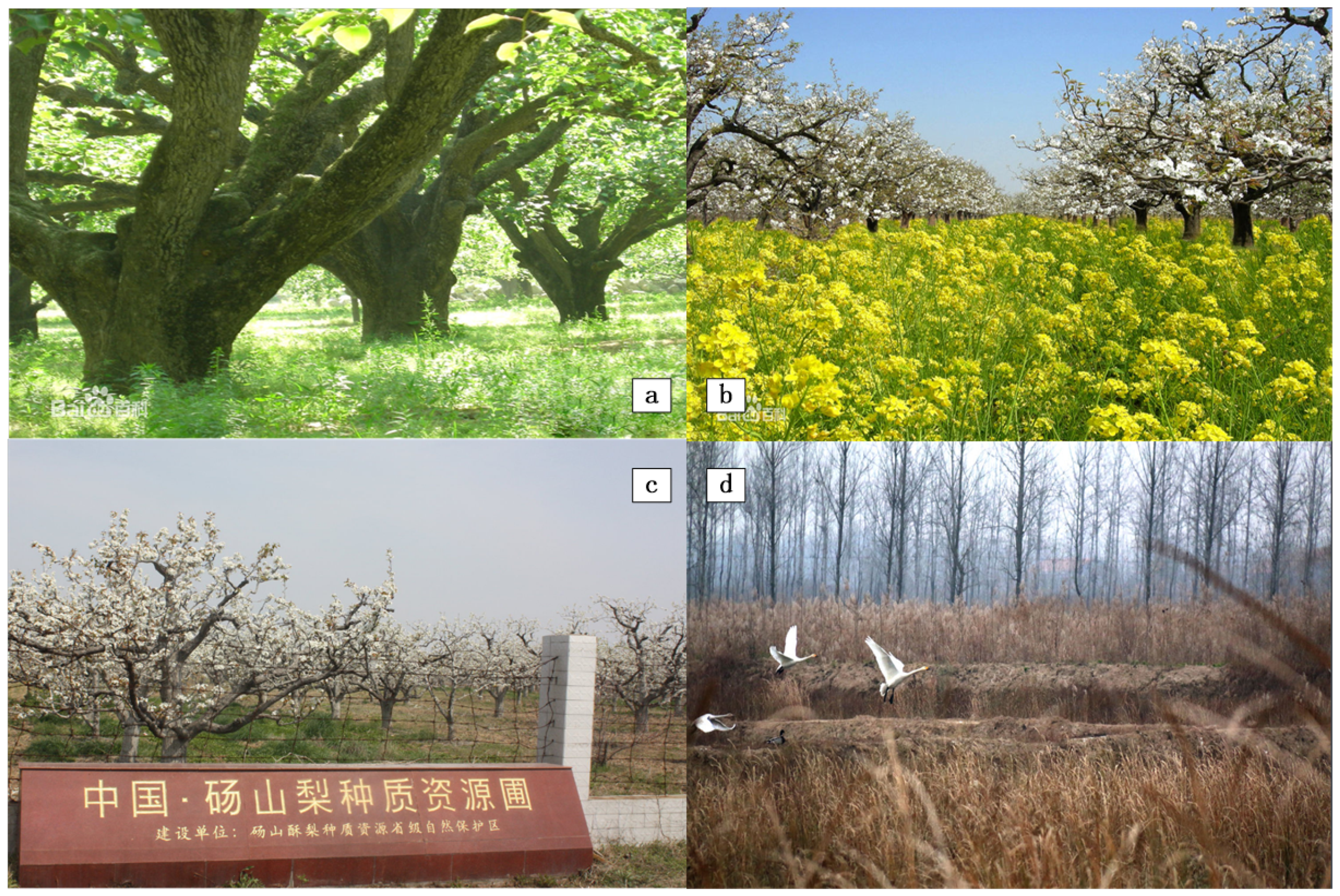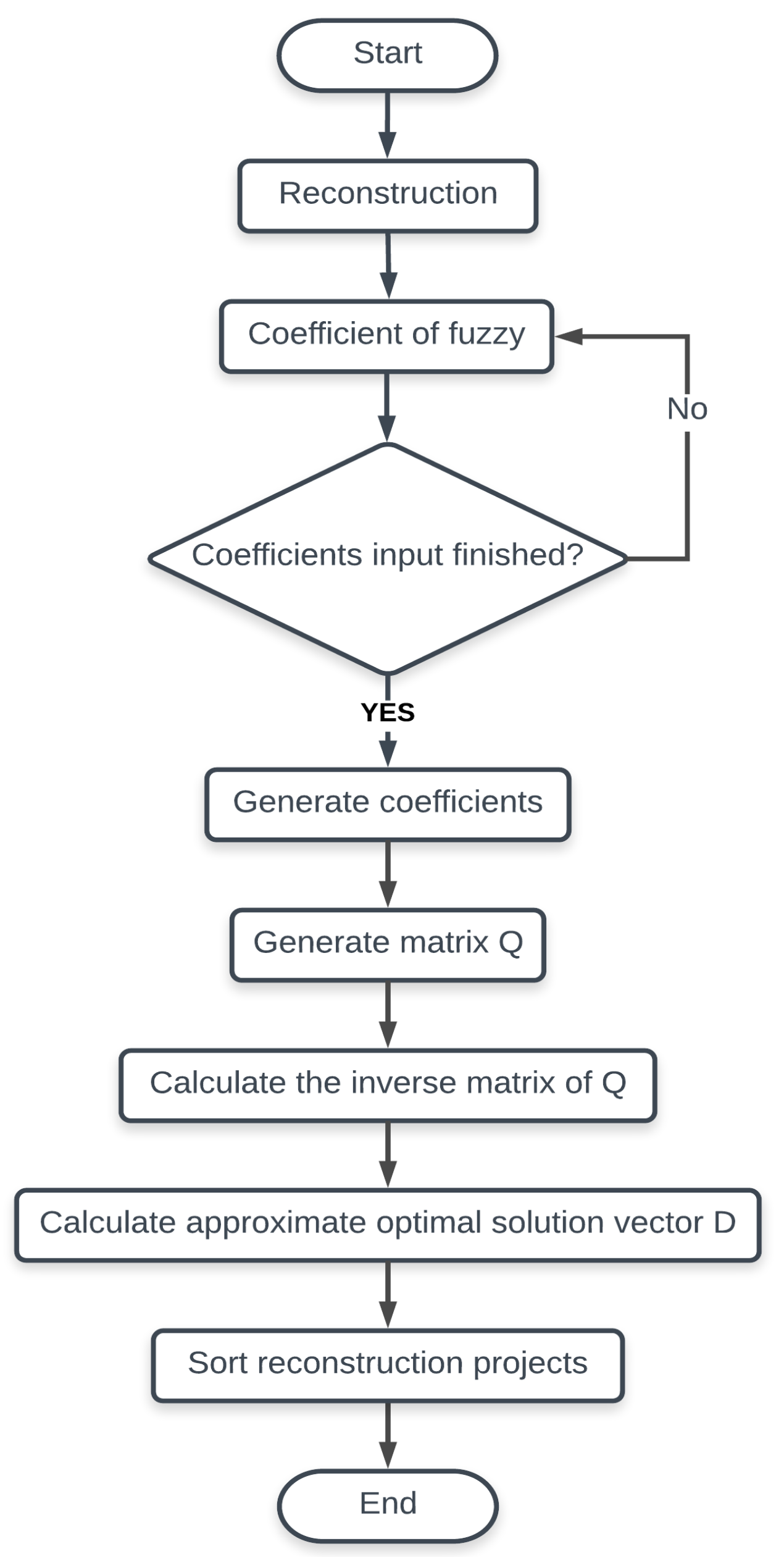1. Introduction
With the massive changes brought about in the information era, China has been deeply affected. A series of successive information technologies have been applied to agriculture, resulting in the development of technologies such as precision agriculture, orchard informatization, digital orchard management, and precision orchard management. Precision orchard management is not only an important part of orchard management, but also the main research direction of precision agriculture. Because China has a large fruit industry, there is a need to apply precision orchard management technology to deal with the huge production in a better way.
Precision agriculture is a modern agricultural operation technology system that comprises a set of technologies that combines sensors, information systems, enhanced machinery, and informed management to optimize production by accounting for variability and uncertainties within agricultural systems [
1]. The goal of precision agriculture is to manage the inputs on site to get the maximum production [
2]. At present, precision agriculture technology has been studied in China and other countries at multiple levels with multiple perspectives. Related technologies can provide a technical reference for the accurate management of orchards [
3]. However, fruit trees and orchards have their own characteristics, especially in the Nature Reserve of Dangshan Pear Germplasm Resources. The Nature Reserve of Dangshan Pear Germplasm Resources is located in Dangshan County, Anhui Province, China. It includes 17 villages in Dangshan County. The protected features include not only more than 10 Dangshan Crisp Pear germplasm resources, more than 40,000 pear trees of over 100 years old, but also the Yellow River wetland and its ecological system. The general situation of the Nature Reserve of Dangshan Pear Germplasm Resources is shown in
Figure 1. Therefore, the management of this nature reserve is different from general nature reserves which are strictly protected, and it is an open protection area for the protection of Crop Germplasm resources. There is not only the government managing the reserve, but also local farmers producing fruit trees, as well as tourists visiting the nature reserve. Therefore, different types of people have different objects of concern in protected areas. By investigating the preferences of different groups of people, the main features in the reserve are sorted according to preference, which will give different groups a better experience of the reserve.
To improve the accuracy of user decision making and the level of precision management, we applied a ranking method for user recommendation based on fuzzy preference relations. Fuzzy set theory was proposed in 1965 by Zadeh, and many scholars have since used it to solve decision making problems [
4]. These problems include supplier selection [
5], investment load evaluation [
6], ordinal peer assessment [
7], 0–1 mixed programming [
8], RFID technology selection [
9], etc. Fuzzy set theory is used to manage the uncertainty in decision making and optimization problems, as ranking of fuzzy numbers is the most important part of decision process in these problems [
10]. Since then, several types of fuzzy sets have been proposed such as intuitionistic fuzzy sets, interval-valued fuzzy sets, interval-valued intuitionistic fuzzy sets, hesitant fuzzy sets, type-2 fuzzy sets, and fuzzy multisets. These types have been used in scientific and real life problems.
In most cases, it is very difficult for a human to make a choice if it depends on some numerical factors. Therefore, decision making is very important in real life. Group decision making is a process to get the optimal solution from a set of solutions under certain criteria and the solutions are evaluated by multiple decision makers under that criteria. The decision makers can give their suggestions in the form of preference of solutions and also provide the comparison between one solution and another solution, this kind of comparison is called preference relation. Preference relation is a great tool to model decision making problems and is used to represent decision making problems [
11]. Different kinds of preference relations have been proposed, for example multiplicative fuzzy preference relations [
12], incomplete fuzzy preference relations [
13], interval fuzzy preference relations [
14], intuitionistic fuzzy preference relations, and hesitant fuzzy preference relations [
15,
16]. Many researchers have applied different fuzzy preference relationship methods to solve decision making problems [
8,
9]. These methods include the multiplicative preference relationship [
17], the triangular multiplicative fuzzy preference relationship [
18], and multiplicative consistent fuzzy preference relations [
19]. As a result of a lack of knowledge, a shortage of time, and an unavailability of data resources decision makers often provide their preferences in the form of numerical values. To handle such situations, we proposed and solved the fuzzy preference relations. The fuzzy preference relation model refers to choosing the best solution from the feasible solution set
where
. The key problem in fuzzy set theory is how to rank the fuzzy numbers. The ranking method for fuzzy numbers was first presented by Jain in 1976 [
20]. Yao and Wu introduced a ranking method for fuzzy numbers based on the decomposition principle [
21]. Later Gu and Xuan proposed a ranking method for generalized L-R fuzzy numbers based on possibility theory [
22].
From the above studies, researchers have applied fuzzy set theory or preference relation theory to the evaluation of decision-making problems. On the basis of the preference relationship of the decision analysis process, the basic method is to get its priority by integrating the preference information of the alternative properties. In the decision-making process, the preference value in the preference relationship must satisfy the logical form of thinking. However, traditional multi-criteria decision-making methods are generally only applicable to the small number of decision-makers, how to use this decision-making method to deal with the public participation in public project decision-making issues, and the existing results have relatively little research in this field. Some scholars adopt the method of clustering the public group first and then evaluating it, which is a more reasonable and feasible way to deal with the problem of public group in the known method. The order of preference items of different groups to be solved in this paper is also related to the public group, but it has definite group classification. Therefore, this study does not need to conduct pre-decision-making clustering work, as long as the different user groups examine the preference information, the fuzzy preference relationship ranking model for decision making can be built.
In this paper, the Nature Reserve of Dangshan Pear Germplasm Resources was selected as the research location, and experts and representatives of different roles (government, farmers, and tourists) were invited to give the fuzzy preference relation coefficients. Then, the fuzzy preference relations model was proposed and solved using the Lagrange function to obtain the ranking values of the user preference recommendation function. Finally, the results of sorting were applied to the precision management of the Nature Reserve of Dangshan Pear Germplasm Resources.
The paper is organized as follows. In
Section 1, previous work is presented.
Section 2 discusses the ranking method based on fuzzy preference relations for user recommendation.
Section 3 contains the requirements analyses, data collection, experiments results and analyses.
Section 4 concludes the paper and gives the future prospects.
2. Ranking Model for Alternatives Based on Fuzzy Preference Relations
The human decision making process is a process of the interpretation of people’s evaluation and selection of things. The priority of the items to be sorted is difficult to distinguish with distinct boundaries. Fuzzy logic can be well used to reflect the thinking process of people analyzing and dealing with things. Therefore, in the process of decision analysis, the fuzzy preference information of decision-makers often needs to be considered. The preference information of decision makers for attributes or alternatives is generally expressed as a preference relation matrix. Because the ranking of the main features in the reserve is a complex decision-making problem, it is often difficult for different groups to give the ranking results of the main features in the reserve directly. However, it is easy for users to compare the priority of two items, so the preference relation matrix is suitable for describing the preference information of different groups to the main features in the reserve.
The approach for the user recommendation projects in the reserve is to select the optimal solution from a limited set of project-sorting solutions, such as . In the process of project sorting, the decision information used in the model is a kind of fuzzy preference relation that users provide about the sorting scheme. On the basis of the fuzzy preference relation and the requirements of reserve management, the preference ranking model of different user groups to the main features in the reserve was established. Users provided some information which is a type of fuzzy preference relations. We used a fuzzy relation matrix P to represent the fuzzy preference relations, where . The corresponding membership function is where , which indicates that the item x is superior to the preference degree of the item y. is a decimal between 0 and 1. Matrix is complementary matrix, that is to say .
On the basis of the above-mentioned fuzzy preference relations, we propose a ranking model for user recommendation projects.
Suppose that the ranking result of the user recommendation project
X is
D, where
. In order to obtain the value of
D, the following approximate relational expression is expected:
It can be seen that the larger the value of
, the larger the value of
. Therefore, the following optimization model with constraints based on the relationship between
and
is proposed.
In order to analyze conveniently, the above model can be transformed to the following ones:
We established a Lagrangian function to solve the proposed optimization model. The solution process is shown below. The flowchart of the model is shown in
Figure 2, and the solution process is given below.
Set the Lagrangian function to be
L.
From Equation (
5), we can find the value of the approximate optimal solution
D. Model output is vector
D (the ranking vector of recommended projects):
Through the above analysis, programming languages can be used to solve the proposed model. We applied MATLAB to perform experiments and solved the proposed models.







